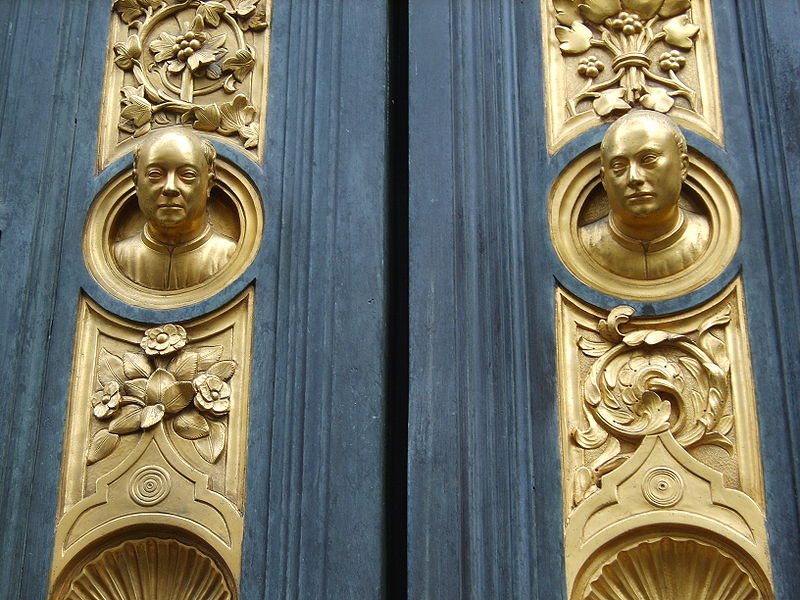Saturday, January 15th, 2011
Lorenzo Ghiberti and Vittorio Ghiberti
Art historians have previously discussed how Ghiberti’s self-portrait on the “Gates of Paradise” doors (shown on the far left of the image, 1424-52, see detail image here) can be interpreted not only as a signature portrait, but also as a promotional image.1 By placing his portrait in such a prominent public location, there is little doubt that Ghiberti was interested in promoting himself as an artist. Catherine King also records that “the Latin inscription alongside [the doors] reads in translation: ‘Made with wonderful skill by Lorenzo Ghiberti.'”2
This past week, when looking at dates and details regarding the “Gates of Paradise,” I was struck with an additional idea. The “Gates of Paradise” were completed in 1452, when Ghiberti would have been about 74 or 75 years old. Therefore, at such a late point in the artist’s life, it is not surprising that Ghiberti decided to include his son Vittorio’s portrait on the door as well (see portrait on right side of the image). Vittorio inherited the family workshop after his father’s death (which was in 1455, only three short years after the “Gates of Paradise” were finished). I think that Lorenzo has anticipated his death (at least to some degree) by including his heir’s portrait. That way, even after Lorenzo died, the Ghiberti family business would still be promoted on the baptistery doors.
Smart thinking, Lorenzo.
As other historians have noted, Lorenzo was quite a “shrewd” and “keen” businessman.3 The inclusion of Vittorio’s portrait seems to be further evidence for this fact.
1 Catherine King, “Italian Artists in Search of Virtue, Fame, and Honour c. 1450-1650,” in The Changing Status of the Artist by Emma Barker, Nick Webb and Kim Woods, eds. (London: Yale University Press, 1999), 60-63.
2 Ibid.
3 Ibid., 59. See also Gary M. Radke, ed., The Gates of Paradise: Lorenzo Ghiberti’s Renaissance Masterpiece (London: Yale University Press, 2007), 67. Citation available online here.

Sorry about the double post, I forgot the hyperlink in the above version!!
Great post M! You are becoming a super-authority on the 'Gates of Paradise'!
Ghiberti was indeed a shrewd businessman. When competing against Brunelleschi for the contract, both turned in wonderful entries of the 'Sacrifice of Isaac' but the contract went to Ghiberti because he came cheaper!
I know you've seen it M, but just in case some of your newer readers may be interested – here is a nice video about the competition panels Ghiberti and Brunelleschi submitted for the 'Gates'
http://bit.ly/hQZAK7
H
That makes a lot of sense. Is he also drawing a parallel between artistic production and biological reproduction? Both gate and son being (in different ways) Ghiberti's "creations."
They look almost exactly the same.
Thanks for the comments!
H Niyazi: You've brought up a great point about how Ghiberti's "Sacrifice of Isaac" (for the 1401 competition) were likely chosen because his work was less expensive to produce. Ghiberti's "Sacrifice of Isaac" panel was cast in one piece (whereas Brunelleschi's submission was cast in seven pieces). Although we don't have record of the judges' deliberations for the contest, it is likely that Ghiberti was chosen because of the cost factor. That being said, I do think that Ghiberti's submission also emphasizes naturalism and Classicism better than Brunelleschi's panel. (I don't doubt that Ghiberti's technical and artistic abilities also influenced the judges!) 🙂
Ben: I love that thought! Yeah, I do think that a parallel can be made with Ghiberti as an artistic and biological "creator." Fun idea.
heidenkind: They do look related, don't they? 🙂